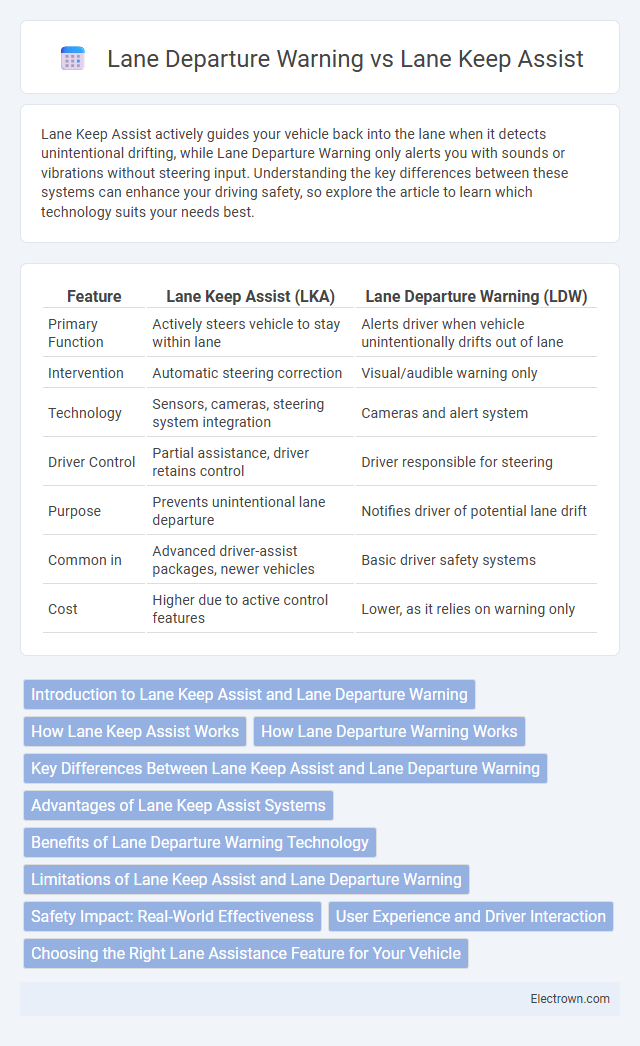Lane Keep Assist actively guides your vehicle back into the lane when it detects unintentional drifting, while Lane Departure Warning only alerts you with sounds or vibrations without steering input. Understanding the key differences between these systems can enhance your driving safety, so explore the article to learn which technology suits your needs best.
Table of Comparison
| Feature | Lane Keep Assist (LKA) | Lane Departure Warning (LDW) |
|---|---|---|
| Primary Function | Actively steers vehicle to stay within lane | Alerts driver when vehicle unintentionally drifts out of lane |
| Intervention | Automatic steering correction | Visual/audible warning only |
| Technology | Sensors, cameras, steering system integration | Cameras and alert system |
| Driver Control | Partial assistance, driver retains control | Driver responsible for steering |
| Purpose | Prevents unintentional lane departure | Notifies driver of potential lane drift |
| Common in | Advanced driver-assist packages, newer vehicles | Basic driver safety systems |
| Cost | Higher due to active control features | Lower, as it relies on warning only |
Introduction to Lane Keep Assist and Lane Departure Warning
Lane Keep Assist (LKA) actively corrects a vehicle's steering to maintain lane position, reducing the risk of unintended lane drifting. Lane Departure Warning (LDW) provides visual or audible alerts when the vehicle begins to move out of its lane without signaling. Both systems enhance road safety by addressing lane discipline but differ in intervention level, with LKA offering corrective input and LDW acting as a cautionary alert.
How Lane Keep Assist Works
Lane Keep Assist uses cameras and sensors to detect lane markings, continuously monitoring your vehicle's position on the road. When it identifies unintentional drifting without a turn signal, the system applies gentle steering corrections to keep your vehicle centered within the lane. This proactive technology enhances safety by preventing potential lane departures, reducing the risk of collisions caused by driver distraction or fatigue.
How Lane Departure Warning Works
Lane Departure Warning (LDW) uses cameras and sensors to monitor your vehicle's position within lane markings, alerting you through visual, auditory, or haptic warnings when unintended lane drifting occurs. This system does not actively steer but relies on timely alerts to prompt corrective actions. Understanding how LDW functions helps you maintain safer driving habits and prevent potential collisions caused by accidental lane departures.
Key Differences Between Lane Keep Assist and Lane Departure Warning
Lane Keep Assist actively steers your vehicle back into its lane when it detects unintentional drifting, while Lane Departure Warning only alerts you through visual or auditory signals without taking corrective action. Lane Keep Assist integrates with the vehicle's steering system, providing subtle inputs to maintain lane position, whereas Lane Departure Warning relies solely on driver intervention after a warning. Your choice depends on whether you prefer automated intervention or just an alert to stay attentive during driving.
Advantages of Lane Keep Assist Systems
Lane Keep Assist systems offer significant advantages by actively steering your vehicle to maintain lane position, reducing the risk of unintentional lane drift compared to Lane Departure Warning, which only alerts you. This proactive intervention enhances safety, especially on highways or during long drives when driver fatigue increases. Your vehicle benefits from improved lane discipline, minimizing accidents caused by distracted or drowsy driving.
Benefits of Lane Departure Warning Technology
Lane Departure Warning technology alerts drivers when their vehicle unintentionally drifts out of its lane, reducing the risk of collisions caused by inattentive driving or drowsiness. This system enhances road safety by providing timely audio or visual alerts, allowing you to correct your steering and maintain proper lane positioning. Compared to Lane Keep Assist, which actively steers the car, Lane Departure Warning offers a less intrusive method to prevent lane departure, making it a valuable feature for cautious drivers.
Limitations of Lane Keep Assist and Lane Departure Warning
Lane Keep Assist may struggle in poor weather conditions, such as heavy rain or snow, and can be less effective on roads with unclear or faded lane markings, limiting its reliability. Lane Departure Warning systems rely heavily on visual detection and may generate false alerts or fail to warn if the driver intentionally changes lanes without signaling. Understanding these limitations helps you maintain attentive driving and avoid overreliance on these safety features.
Safety Impact: Real-World Effectiveness
Lane Keep Assist actively corrects your steering to maintain lane position, significantly reducing the risk of unintentional lane departures and potential collisions. Lane Departure Warning alerts you with visual or audible signals when drifting out of your lane but does not intervene, relying on your immediate reaction to prevent accidents. Studies show Lane Keep Assist generally offers a higher safety impact in real-world conditions by directly helping you stay in your lane and avoid side-swiping or run-off-road crashes.
User Experience and Driver Interaction
Lane keep assist actively corrects steering to maintain lane position, reducing driver fatigue and enhancing confidence during lane-centered driving. Lane departure warning alerts the driver through audible or visual signals when unintentional lane drifting occurs, prompting manual correction without automatic intervention. The user experience with lane keep assist feels more supportive and intuitive, while lane departure warning demands consistent driver attention and reactive input.
Choosing the Right Lane Assistance Feature for Your Vehicle
Lane Keep Assist uses steering inputs to help keep your vehicle centered in its lane, reducing the risk of unintentional drifting, while Lane Departure Warning alerts you with visual or auditory signals if you begin to veer out of your lane without signaling. Selecting the appropriate lane assistance feature depends on your driving habits and safety preferences, with Lane Keep Assist offering active correction and Lane Departure Warning serving as a passive alert system. Advanced systems may combine both features to enhance road safety through proactive intervention and timely alerts.
Lane keep assist vs Lane departure warning Infographic

 electrown.com
electrown.com